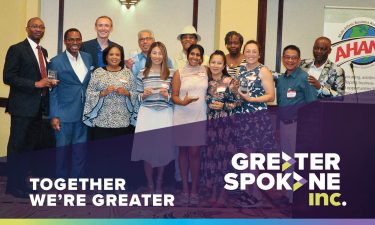Ariane Schmidt, Executive Director, Spokane Regional Broadband Development Authority BROADLINC
No one could have imagined just a few short years ago how important broadband, and the ability to access high-capacity Internet, would become for our households, businesses, and anchor institutions for basic community vitality. One lasting impact of the COVID-19 pandemic has been the stark realization of how much the Internet is a part of our daily lives.
Those who had reliable Internet could live at home, work at home, learn at home, and have community at home. Those without had even a deeper sense of isolation than just physical quarantine.
Broadband has become the new modern essential utility. Not unlike clean water, waste management services, and electricity, broadband ensures household opportunity and resiliency. Now that we are out of the pandemic, individuals and communities alike have decided this issue is important enough to work alongside one another in a common desire to create resiliency for the future.
The federal government has released massive amounts of funding dedicated to broadband with its first focus on rural, unserved communities. This by no means ignores the impact of broadband accessibility in our urban cores. It does, however, highlight that the absence of infrastructure for broadband compounds barriers for individuals with a lack of disposable income and the digital literacy that can be addressed once the service is made available.
In 2021, the Spokane County Commissioners had the foresight to know broadband was on the horizon and would only get bigger. As part of their $101 Million American Rescue Plan (ARP) allocation, they set aside $10 Million for an unprecedented allowance of federal match funding dedicated to broadband. They also directed funding to several key broadband-focused projects. As the rest of 2022 unfolded, they realized the cities, businesses, and nonprofits within Spokane County also collectively viewed broadband as a joint priority in their 2022 Council of Governments. The movement in public broadband throughout the county culminated in the creation of the Spokane Regional Broadband Development Authority BROADLINC in December 2022. The Commissioners realized that they wanted publicly funded broadband infrastructure assets to remain public assets. Not unlike roads and bridges on which everyone can travel, they wanted the new digital highways to be accessible to multiple internet service providers (ISPs) and affordable and sustainable to end users. BROADLINC was formed with this end in mind.
BROADLINC has been influential at the state and federal levels in policy creation to the extent that broadband serviceable locations (BSLs) now exist in Spokane County. BROADLINC followed the recommendation used throughout Washington state to analyze the Federal Communications Commission (FCC) Fabric Map location points against local Emergency 911 data to determine what addresses were missing. The result was over 22,000 points in Spokane County alone and over 100,000 points across the state. The FCC accepted all the request points for Spokane and is still reviewing the points for the rest of the state. This revision resulted in the 1.2 billion dollars of funding coming to our state in Broadband Equity Access and Deployment (BEAD) funding starting in 2024.
BROADLINC continues to work with tribes, counties, cities, and the Washington State Broadband Office (WSBO) to comply with funding regulations and at the same time meet the unique needs in our community as well as the communities throughout the state. This includes the Spokane Broadband Action Team (BAT) which is an advisory group composed of hundreds of business members and dozens of organizations helping to inform the strategic initiatives for projects in unserved communities.
Funding for broadband projects is coming from multiple sources in areas that before never touched Internet-hospital-home, mental health and behavioral health telehealth access, remote learning, and workforce opportunities to enable them to all work together. What lies before us is the ability to turn “snow days” into “virtual days” when every student has access to learn remotely. We can enable patients to be monitored safely from their homes rather than requiring unneeded, costly travel to medical centers. We can offer the ability for families that want to live in a rural environment to bring remote careers to small towns, thus preserving and curating vibrant communities.
This Digital Divide is the difference between having Internet access and navigating the Internet well. These same elements exist in our urban core where infrastructure may exist, but individuals may need a helpful hand to come alongside to assist them in understanding how to make their disposable income go a little further, or how to get a computer to run their business. Digital Navigators can turn language and culture barriers into the next step to digital literacy.
I could not be more hopeful for the path ahead.




